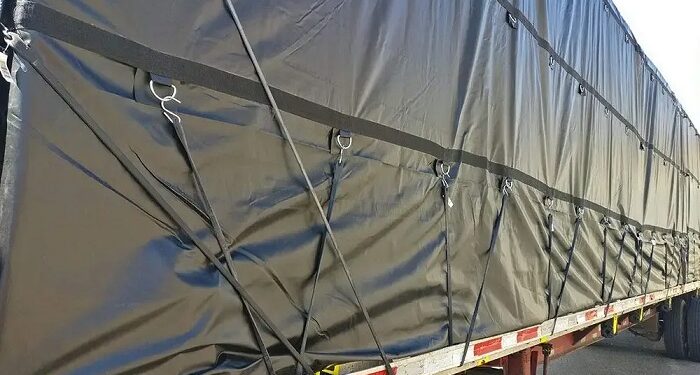Transporting aerospace components from Kentucky factories demands meticulous attention to freight care, especially when using an aerospace flatbed. These specialized loads require more than just standard tarping — they need precise techniques to ensure safety, prevent damage, and maintain compliance with industry regulations.
Flatbed tarping for aerospace parts involves using high-quality parachute tarps that shield delicate surfaces from environmental hazards like dust, moisture, and UV exposure. Incorporating anti-chafe pads and soft straps minimizes friction and secures the cargo without causing damage. A properly designed load cradle further stabilizes components, reducing the risk of shifting during transit.
Moreover, addressing issues like wind whip is critical to prevent tarp flapping that could compromise the load’s integrity. Regular quality audits ensure that every tarping job meets stringent standards, safeguarding Kentucky components en route to their destination.
In this guide, we’ll explore the bestflatbed trucking jobs tarping techniques tailored to aerospace freight, focusing on durability, precision, and reliability to protect your valuable cargo every mile of the way.
2. Unique Challenges of Kentucky Components Transportation
Transporting Kentucky components on aerospace flatbeds presents distinct challenges that demand expert tarping and freight care:
- Varied Component Sizes and Shapes: Aerospace parts often have complex geometries requiring custom load cradles for secure placement and effective tarping with parachute tarps to ensure full coverage.
- Exposure to Kentucky’s Variable Weather: Frequent shifts between rain, heat, and humidity increase the risk of moisture damage, making high-quality tarps and moisture-resistant materials essential.
- Preventing Damage from Vibration and Movement: Soft straps combined with anti-chafe pads are crucial to minimize friction and secure loads firmly, reducing the risk of abrasion during transport.
- Wind Whip Risks on Open Flatbeds: Kentucky’s open highways can cause tarp flapping; careful tensioning and strategic fastening prevent wind whip that compromises cargo integrity.
- Maintaining Regulatory Compliance: Regular quality audits ensure all tarping methods meet aerospace industry standards, safeguarding Kentucky freight every mile.
Addressing these challenges with precise tarping techniques guarantees safe, efficient transport of valuable aerospace components from Kentucky factories.
3. Essential Equipment: Parachute Tarps and Anti-Chafe Pads
Using the right equipment is vital for effective aerospace flatbed tarping of Kentucky components. Key items include:
- Parachute Tarps: Lightweight yet durable, these tarps offer superior protection against moisture, UV rays, and dust. Their breathable fabric prevents condensation buildup, crucial for sensitive aerospace parts.
- Anti-Chafe Pads: Placed between straps and the cargo, these pads reduce friction and abrasion, safeguarding delicate surfaces during transport.
- Soft Straps: Paired with anti-chafe pads, soft straps firmly secure loads without damaging components, minimizing movement and vibration.
- Load Cradles: Custom-designed cradles stabilize irregularly shaped parts, ensuring even weight distribution and preventing shifting under transit stresses.
- Wind Whip Prevention Tools: Proper tarp tensioning and fastening hardware minimize tarp flapping, maintaining cargo integrity amid Kentucky’s changing weather.
Incorporating these essential tools with precision not only enhances freight care but also ensures compliance during quality audits, protecting your aerospace freight from Kentucky factories every mile of the journey.
4. Implementing Soft Straps and Load Cradles for Damage Prevention
Effective freight care for Kentucky components on aerospace flatbeds relies heavily on soft straps and load cradles. Soft straps, used alongside anti-chafe pads, provide gentle yet secure tension, minimizing abrasion and preventing damage during transit. Custom load cradles are essential for stabilizing irregularly shaped parts, evenly distributing weight and reducing movement that could cause impact or stress. Together, these tools work to combat challenges like wind whip and vibration, maintaining cargo integrity beneath parachute tarps. Incorporating soft straps and load cradles strengthens your tarping strategy, ensuring aerospace components arrive safely and pass every quality audit with confidence.
5. Techniques to Minimize Wind Whip During Transit
Minimizing wind whip is crucial when tarping aerospace flatbed loads carrying Kentucky components. Start by applying consistent tension on parachute tarps using soft straps combined with anti-chafe pads to prevent abrasion and secure the tarp tightly around the load cradle. Employ strategic fastening points along the flatbed’s frame to distribute pressure evenly, reducing tarp flapping caused by wind gusts. Additionally, consider using edge reinforcements on tarps to resist tearing from constant movement. Regularly inspect tension and fastening during stops to ensure stability. These proactive wind whip prevention techniques enhance freight care quality, protect sensitive aerospace parts, and help pass stringent quality audits, ensuring your Kentucky components arrive damage-free and compliant every mile of transit.
6. Quick-Remove Systems for Efficient Freight Care
In aerospace flatbed tarping for Kentucky components, time-efficient freight care is essential without compromising protection. Quick-remove systems offer a smart solution, enabling rapid tarp removal and reapplication during inspections or quality audits. These systems typically integrate easy-release buckles or cam straps paired with soft straps and anti-chafe pads, ensuring secure fastening yet effortless adjustment.
Using quick-release mechanisms reduces downtime at checkpoints, allowing crews to access delicate aerospace parts swiftly while maintaining the integrity of parachute tarps and load cradles. Moreover, these systems help minimize wear-and-tear caused by frequent tarping adjustments, preserving tarp longevity and consistent wind whip prevention.
By incorporating quick-remove hardware into your tarping setup, Kentucky freight handlers can balance rigorous freight care standards with operational efficiency. This approach keeps aerospace components protected under tight schedules, streamlines compliance during audits, and supports safe, reliable transport every mile of the route.
7. Quality Audit Protocols in Aerospace Flatbed Tarping
Ensuring impeccable freight care for Kentucky components demands rigorous quality audit protocols in aerospace flatbed tarping. Auditors focus on verifying that parachute tarps are properly positioned and tensioned, eliminating any slack that could invite wind whip or moisture intrusion. Inspecting the use of anti-chafe pads and soft straps is critical to confirm that delicate surfaces remain protected against abrasion and that straps are neither over-tightened nor loose. The integrity and customization of load cradles also undergo thorough evaluation to guarantee stable, vibration-free support for complex aerospace parts.
During audits, inspectors assess fastening points and quick-remove systems to ensure they maintain security without compromising efficiency. They also check that the materials and techniques conform to aerospace industry standards, emphasizing durability and damage prevention throughout transit. Meticulous documentation of each tarping session helps track compliance and identify areas for continuous improvement.
By adhering strictly to these quality audit protocols, Kentucky freight teams reinforce their commitment to safe, damage-free transport. This systematic approach not only protects sensitive aerospace components but also bolsters trust with clients and regulators, solidifying Kentucky’s reputation for excellence in aerospace flatbed tarping.
8. Conclusion: Ensuring Damage-Free Delivery of Aerospace Components
In transporting delicate aerospace components from Kentucky factories, mastering flatbed tarping techniques is crucial to guarantee damage-free delivery. As explored, selecting the right tarp material and properly securing it shields sensitive parts from harsh weather, debris, and road vibrations. Customizing tarping methods to component size and shape ensures optimal protection while maintaining compliance with transportation regulations. Additionally, employing best practices such as thorough inspection, tension control, and advanced fastening systems minimizes risks of tarp failure during transit. Integrating these strategies not only preserves component integrity but also enhances supply chain reliability and customer satisfaction. By prioritizing innovative flatbed tarping solutions tailored for aerospace demands, Kentucky manufacturers can confidently deliver high-value parts safely across long distances. This comprehensive approach underscores the vital role of expert tarping techniques in safeguarding aerospace investments from factory floor to final assembly — ultimately supporting the industry’s commitment to precision, quality, and operational excellence.
FAQ
- 1. What are the key considerations when tarping aerospace components on flatbed trucks?
Key considerations include ensuring the tarp is made from durable, weather-resistant material; securely fastening the tarp to prevent movement during transit; and avoiding any sharp edges or contact points that could damage sensitive aerospace parts.
- 2. How do Kentucky factories ensure compliance with aerospace transport standards using flatbed tarping?
Kentucky factories follow industry regulations by using certified tarping materials, conducting thorough inspections before and after loading, and training personnel in proper tarping techniques specific to aerospace components.
- 3. What techniques are recommended for securing tarps on irregularly shaped aerospace components?
Techniques include using custom-fit tarps or adjustable straps, employing padding to protect delicate surfaces, and utilizing multiple tie-down points to evenly distribute tension and prevent tarp slippage.
- 4. How often should tarps be inspected during transit for aerospace shipments?
Tarps should be inspected at regular intervals during transit, especially after stops or rough road conditions, to ensure they remain tight and intact, preventing exposure to environmental elements.
- 5. Can flatbed tarping protect aerospace components from environmental hazards common in Kentucky?
Yes, when properly applied, flatbed tarping can protect aerospace components from rain, dust, and debris typical of Kentucky’s climate, reducing the risk of contamination or damage during transportation.
Call to Action
Unlock expert flatbed tarping tips for your aerospace cargo—click now to read the full article or contact us today for personalized solutions!
































